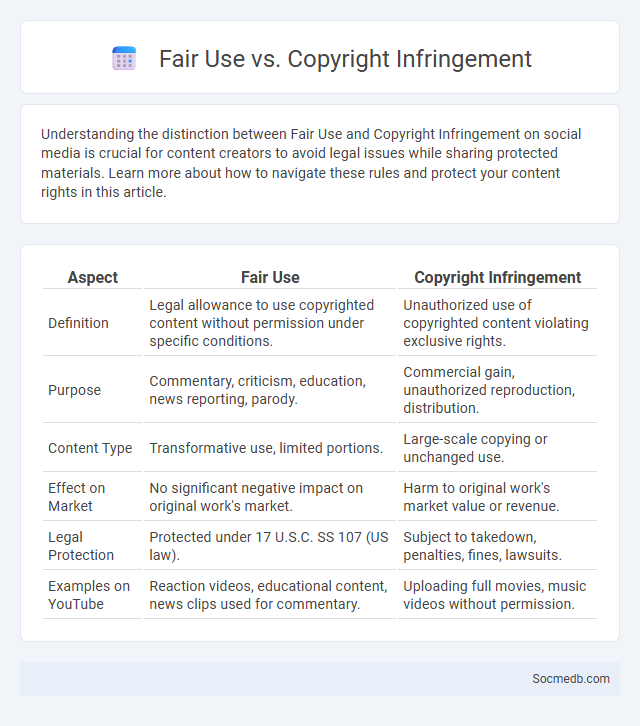
Photo illustration: Fair Use vs Copyright Infringement
Understanding the distinction between Fair Use and Copyright Infringement on social media is crucial for content creators to avoid legal issues while sharing protected materials. Learn more about how to navigate these rules and protect your content rights in this article.
Table of Comparison
| Aspect | Fair Use | Copyright Infringement |
|---|---|---|
| Definition | Legal allowance to use copyrighted content without permission under specific conditions. | Unauthorized use of copyrighted content violating exclusive rights. |
| Purpose | Commentary, criticism, education, news reporting, parody. | Commercial gain, unauthorized reproduction, distribution. |
| Content Type | Transformative use, limited portions. | Large-scale copying or unchanged use. |
| Effect on Market | No significant negative impact on original work's market. | Harm to original work's market value or revenue. |
| Legal Protection | Protected under 17 U.S.C. SS 107 (US law). | Subject to takedown, penalties, fines, lawsuits. |
| Examples on YouTube | Reaction videos, educational content, news clips used for commentary. | Uploading full movies, music videos without permission. |
Understanding Fair Use: Definition and Principles
Fair Use is a legal doctrine that allows limited use of copyrighted material without permission for purposes such as commentary, criticism, news reporting, education, or research. Key principles include evaluating the purpose of use, the nature of the copyrighted work, the amount used, and the effect on the market value of the original. Understanding Fair Use helps You navigate social media content responsibly while respecting intellectual property rights.
What Constitutes Copyright Infringement?
Copyright infringement on social media occurs when users post or share content such as images, videos, music, or text without obtaining proper authorization from the original copyright holder. This includes unauthorized reproduction, distribution, public display, or creation of derivative works based on protected content. Platforms enforce strict policies to detect and remove infringing materials, aligning with laws like the Digital Millennium Copyright Act (DMCA).
Deciphering a Copyright Claim
Deciphering a copyright claim on social media involves analyzing the ownership of digital content and understanding platform-specific policies, such as those of YouTube, Facebook, and Instagram. Identifying the original creator, the type of copyrighted material, and the context of use helps determine if the claim is valid or a potential misuse of copyright enforcement. Effective resolution often requires submitting counter-notices or licenses to avoid content removal or account penalties, ensuring compliance with the Digital Millennium Copyright Act (DMCA) guidelines.
Key Differences: Fair Use vs Copyright Infringement
Fair use on social media allows limited use of copyrighted content without permission for purposes such as commentary, criticism, or education, focusing on factors like purpose, nature, amount used, and market effect. Copyright infringement occurs when original content is used without authorization, harming the rights holder's potential revenue or control over distribution. Social media platforms often navigate these distinctions through content ID systems and copyright policies to balance user creativity and legal compliance.
Legal Grounds for Fair Use Protection
Fair use protection in social media hinges on legal grounds such as commentary, criticism, news reporting, and educational purposes, which allow limited use of copyrighted content without permission. Courts evaluate factors including the purpose of use, the nature of the copyrighted work, the amount used, and the effect on the market value of the original content. Understanding these legal standards helps users navigate content sharing while minimizing copyright infringement risks on platforms like Facebook, Twitter, and Instagram.
Common Examples of Copyright Infringement
Posting copyrighted images, videos, or music without permission is a frequent example of copyright infringement on social media platforms. Using branded logos or content from movies, TV shows, and games without authorization can lead to legal issues. To protect your account, ensure you have rights to share any material or utilize content labeled for free use under licenses like Creative Commons.
Responding to a Copyright Claim: Steps and Strategies
When responding to a copyright claim on social media, promptly review the notice to understand the specific content in question and the basis of the claim. Gather evidence such as licenses, permissions, or fair use justifications to support your response, and submit a counter-notification through the platform's designated process. Employ clear communication to resolve disputes, ensuring compliance with DMCA guidelines and maintaining your account's good standing.
Factors Courts Consider in Fair Use Cases
Courts evaluate factors such as the purpose and character of social media content, emphasizing whether it is transformative or merely a replication. They analyze the nature of the original copyrighted work, assessing its creativity and publishability within social platforms. The amount and substantiality of the portion used relative to the entire work is critical, alongside the potential market impact on the original content's value in the social media ecosystem.
Protecting Your Content: Best Practices
Protecting your content on social media involves using watermarks, copyright notices, and privacy settings to safeguard originality and ownership. Regularly monitoring platforms for unauthorized use and employing digital rights management tools help prevent content theft and misuse. Implementing strong passwords and two-factor authentication ensures secure access to your accounts, reducing the risk of hacking and data breaches.
Fair Use, Infringement, and Claims: FAQs for Creators
Creators navigating social media must understand Fair Use, which allows limited use of copyrighted content without permission for purposes like commentary, criticism, or education. Copyright infringement occurs when content is used without authorization, potentially leading to takedown notices or legal claims filed through platforms' Digital Millennium Copyright Act (DMCA) policies. Frequent FAQs highlight the importance of attributing sources, understanding platform-specific rules, and responding promptly to infringement claims to protect creative rights and avoid penalties.
 socmedb.com
socmedb.com